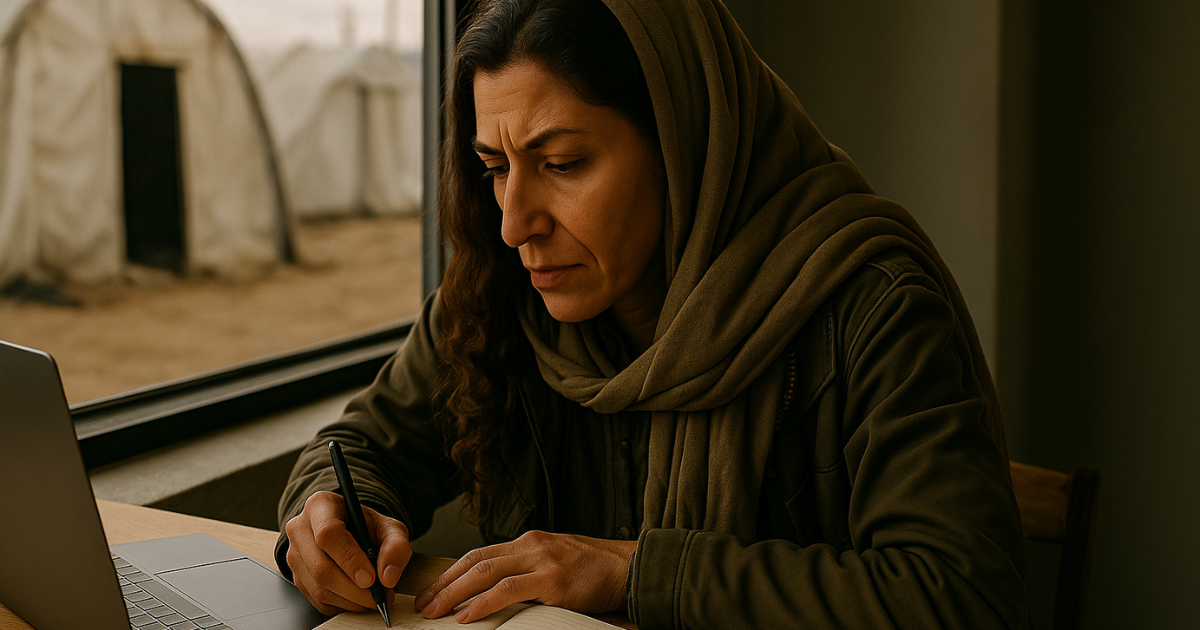The Refugee Author: How War Could Create a New Wave of Exiled Writers

In an age of increasing global conflict, a new generation of displaced writers emerges, carrying their stories across borders and creating literature from the margins of society. These refugee authors navigate not only personal trauma but also complex publishing landscapes, often finding solidarity and opportunity in digital spaces.
The Rising Tide of Literary Displacement
The world is experiencing its highest levels of forced displacement on record. According to the UNHCR Global Trends Report, over 100 million people worldwide have been forcibly displaced from their homes as of 2022, with conflicts in Ukraine, Syria, Afghanistan, and countless other regions driving this humanitarian crisis.

Behind these staggering numbers are individual stories—including those of writers and intellectuals who flee with little more than their creative voices intact. History demonstrates that periods of conflict often yield powerful literary movements forged in exile. From the anti-fascist writers of World War II to Soviet-era dissidents, exile has long been a crucible for literary innovation.
Today’s refugee authors face unique challenges and opportunities. Digital tools provide unprecedented potential for maintaining literary careers across borders, yet the psychological toll of displacement, language barriers, and publishing industry obstacles create significant hurdles.
Historical Patterns: War, Exile, and Literary Production
The relationship between displacement and literary output has deep historical roots. During World War II, approximately 282,000 Jews fled Germany and 117,000 from annexed Austria between 1933 and 1939, including literary giants like Thomas Mann, Hannah Arendt, and Stefan Zweig. Their work, created in exile, profoundly shaped 20th-century literature and philosophy.
The Soviet era produced another significant wave of exiled writers. Joseph Brodsky, Aleksandr Solzhenitsyn, and Milan Kundera developed distinctive literary voices that challenged totalitarianism while navigating life in foreign lands. Solzhenitsyn’s “The Gulag Archipelago,” written in secrecy and smuggled to the West, demonstrates how exile can preserve crucial testimonies that might otherwise be silenced.
More recently, the Syrian civil war has displaced numerous writers who continue to document their country’s tragedy from abroad. According to PEN International, over 100 Syrian writers have been forced into exile since 2011. Poets like Ghayath Almadhoun and novelists like Khaled Khalifa represent a new generation of exiled voices using literature to process collective trauma and preserve cultural memory.
These historical examples reveal recurring patterns: initial disorientation followed by adaptation, linguistic challenges, thematic preoccupation with home and belonging, and often, the development of unique literary forms that reflect fractured experiences.
Contemporary Conflicts and Their Literary Diasporas
Today’s global conflicts are creating new literary diasporas with distinctive characteristics.
Ukraine: Writers in Digital Exile
Russia’s invasion of Ukraine has displaced over 6 million people externally, according to the UNHCR Operational Data Portal. Among them are notable Ukrainian writers like Serhiy Zhadan and Oksana Zabuzhko, who continue writing while advocating for their nation’s sovereignty.
Ukrainian literary voices have gained unprecedented international attention, with translations and publishing opportunities expanding rapidly. Organizations like PEN International have established emergency funds specifically for Ukrainian writers, recognizing that preserving cultural voices is essential during times of war.
Digital publishing platforms have proven crucial for Ukrainian authors, allowing them to maintain connections with readers despite physical displacement. PublishDrive, for instance, has worked with Ukrainian authors to ensure their books remain available globally, demonstrating how digital distribution can preserve literary continuity during conflict.
Afghanistan: Women’s Voices Under Threat
The Taliban’s return to power in 2021 represented a particular threat to women writers, with many forced to flee or go into hiding. The literacy collective Free Women Writers reported that dozens of their members left Afghanistan during the chaotic evacuation, while others destroyed their writings out of fear.
Afghan women’s writing collectives have reorganized in diaspora, with digital platforms enabling continued collaboration despite geographic dispersal. Their work often explores themes of double exile—from both homeland and from autonomous womanhood.
Myanmar: Writers Documenting Democratic Collapse
Since the 2021 military coup, Myanmar has seen a sharp increase in writers seeking exile. According to PEN Myanmar, over 50 writers and journalists have fled the country, while others have been detained or killed.
These writers face the challenge of maintaining ties to rapidly evolving events on the ground while building new audiences abroad. Many collaborate with international rights organizations to document ongoing abuses, using literature as both witness and resistance.
The Psychological Journey of the Exiled Author
Displacement profoundly shapes both the writer and their work. Studies conducted with refugee artists show typical phases in creative adaptation to exile:
- Initial trauma and silence - Many writers experience periods of creative paralysis following forced migration
- Testimonial urgency - A need to document what has been witnessed and lost
- Identity negotiation - Exploring the fractures between past and present selves
- Linguistic transformation - Adapting to new language environments or developing hybrid forms
- Transcultural synthesis - Creating work that bridges cultures and experiences

Research from the University of East London’s Refugee Writing Project indicates that creative writing can serve therapeutic functions for displaced people, offering a means to process trauma and maintain continuity of identity. Yet the pressure to produce “refugee narratives” that conform to Western expectations creates additional tension for many writers.
Syrian novelist Mohja Kahf describes this challenge: “I am expected to write about bombs and fleeing, when sometimes I just want to write about love or ordinary life. The market wants trauma narratives, but we contain multitudes.”
Publishing Challenges and Opportunities
Refugee authors face distinctive obstacles in the publishing ecosystem:
Industry Access Barriers
Breaking into established publishing markets presents numerous challenges:
- Language barriers that limit access to agents and publishers
- Lack of professional networks in new countries
- Limited understanding of unfamiliar publishing norms
- Financial precarity that makes long-form writing difficult
- Legal status uncertainty affecting contract eligibility
Traditional publishing pathways often rely on cultural and social capital that displaced writers haven’t had time to develop. Even acclaimed authors in their home countries may struggle to maintain professional standing after displacement.
Digital Publishing as Solution
Digital publishing platforms have emerged as crucial infrastructure for refugee writers. Self-publishing through services like PublishDrive provides several key advantages:
- Geographic flexibility and borderless distribution
- Lower financial barriers to entry
- Control over intellectual property
- Ability to publish in multiple languages
- Direct relationship with readers worldwide

For authors who may relocate multiple times or face uncertain legal status, digital publishing offers continuity that traditional contracts might not accommodate. PublishDrive’s royalty collection system, for instance, works across international boundaries—a critical feature for writers without stable addresses or banking access.
Translation Challenges and Opportunities
Translation represents both obstacle and opportunity. While finding translators for less commercially dominant languages remains difficult, digital platforms have expanded the market for translated works.
Organizations like Words Without Borders and the Translators Association emergency fund provide resources specifically for displaced writers seeking to reach new language markets. These initiatives recognize that translation is not merely linguistic but cultural translation—helping refugee narratives find contextual understanding in new environments.
Digital Nomadism and Refugee Authorship: Points of Convergence and Divergence
The rise of digital nomadism—location-independent professionals who work while traveling—has created some infrastructural overlap with the needs of refugee authors. Both populations rely on remote work technologies, digital publishing platforms, and borderless payment systems.
However, crucial differences exist:
Digital Nomad Writers
- Voluntary mobility
- Travel privileges (passports, visas)
- Adventure narrative
- Cultural capital in Western markets
- Choice to return home
Refugee Writers
- Forced displacement
- Legal restrictions and uncertainty
- Trauma and loss narrative
- Cultural dislocation
- Inability to return safely
Despite these differences, intersections occur. In countries like Georgia, Portugal, and Turkey, co-working spaces have become hubs where refugee writers and digital nomads interact, fostering informal knowledge exchange networks. Platforms like PublishDrive have observed mentorships forming between these groups, aiding refugee authors in navigating borderless publishing strategies.
Building Community: Support Networks for Refugee Authors
Established Organizations
Several organizations have expanded their focus to support displaced writers:
- PEN International’s Writers in Exile Program: Offers emergency assistance and long-term professional support.
- ICORN (International Cities of Refuge Network): Provides residencies in safe cities for persecuted writers.
- Artistic Freedom Initiative: Delivers legal services specifically for refugee artists and writers.
These entities primarily assist high-profile writers established in their home countries.
Grassroots Networks
For emerging writers or those from less-recognized conflicts, grassroots networks are vital:
- Refugee Writers Collective: Operates in multiple European cities.
- Exiled Writers Ink: UK-based with international reach.
- Asia Pacific Writers & Translators: Supports displaced writers across Southeast Asia.
These groups emphasize community building alongside professional development, acknowledging that creative communities themselves are casualties of conflict.
Digital Communities
Online platforms have become essential for maintaining literary continuity during displacement:
- Virtual writing workshops tailored for refugee authors.
- Social media groups organized by language or region of origin.
- Online literary journals showcasing refugee writing.
- Digital archives preserving works that might otherwise be lost.
PublishDrive’s author forums have organically developed sub-communities where writers from conflict regions share insights on maintaining publishing careers during displacement.
The Publishing Industry’s Response
Traditional publishing houses have shown increased interest in refugee narratives, launching initiatives such as:
- HarperCollins’ “Voices from Elsewhere” imprint.
- Penguin Random House’s diversity fellowships, which include refugee categories.
- Amazon’s Crossing translation fund for writers from conflict regions.
However, critics note that these efforts often favor narratives aligning with Western expectations of victimhood or exoticism. Literary agent Alessandra Bastagli observes that there’s demand for refugee stories, but often very specific ones that confirm rather than challenge readers’ preconceptions.
In contrast, independent and digital publishers like PublishDrive focus on providing practical infrastructure, allowing authors to tell stories beyond expected “refugee literature” categories.
Literary Innovations From Displacement
Exile has historically spurred significant literary innovations as writers respond to the fractures in their lives:
Hybrid Forms
Refugee writers often develop literary forms reflecting their hybrid identities:
- Bilingual or multilingual texts that resist translation.
- Digital literature incorporating visual elements to overcome language barriers.
- Interactive narratives mirroring non-linear experiences of displacement.
- Audio literature preserving oral traditions threatened by displacement.
Thematic Explorations
Common themes in refugee literature include:
- Memory and documentation as acts of resistance.
- Redefining home and belonging beyond territorial boundaries.
- Intergenerational transmission of cultural knowledge.
- Language loss and linguistic adaptation.
- The body as a site of both vulnerability and persistence.
Syrian-American poet Lena Khalaf Tuffaha encapsulates this sentiment: “We carry homes in our mouths, rebuilding them word by word.”
Audience and Reception Challenges
Refugee authors often face complex reception challenges:
- Being expected to represent entire national or ethnic groups.
- Having work read primarily as testimony rather than art.
- Navigating multiple audience expectations across cultures.
- Being valued for biography rather than literary merit.
Digital publishing has mitigated some of these issues by allowing writers to reach diverse audience segments simultaneously, rather than being positioned exclusively as “refugee writers” in any single market.
Digital Tools for the Displaced Author
Several digital tools have proven invaluable for refugee writers:
Publishing Infrastructure
- PublishDrive: Offers global publishing reaching beyond English markets, even in underserved markets plus royalty collection across borders and multiple distribution channels, crucial for authors who may relocate multiple times.
- Canva to design compelling book covers or illustrations for books and covers
- Scribeshadow to translate books with the power of AI into different languages
Writing Resources
- Papyrus: Offline-capable writing software for contexts with unreliable internet.
- Google Docs: Collaborative capabilities that help maintain writing communities despite geographic dispersal.
Community Building
- Discord/Slack communities: Create virtual writing groups maintained across borders.
- Substack/Patreon: Enable direct reader support regardless of location.
- Social audio platforms: Allow for oral storytelling traditions to continue in diaspora.
PublishDrive’s multi-currency royalty system has been particularly beneficial for writers who relocate multiple times, ensuring continuous income regardless of changing circumstances.
Looking Forward: The Future of Exiled Literature
Several trends suggest possible futures for refugee authorship:
Increasing Autonomy Through Technology
As digital tools become more sophisticated, refugee writers gain greater independence from traditional gatekeepers. More author-led publishing initiatives are emerging from displaced communities, controlling both production and distribution of their narratives.
Network Literature Across Borders
Interconnected literary networks are forming among displaced writers from various conflicts. These creative communities develop trans-regional aesthetics and support systems that transcend national boundaries and the limitations of the “refugee writer” category.
Climate Displacement and New Narratives
With projections suggesting 200 million climate migrants by 2050, literature exploring environmental exile is likely to grow as a category. These narratives may bridge current divisions between “political refugees” and “economic migrants” by highlighting systemic interconnections.
Industry Evolution
The publishing industry is expected to develop more nuanced approaches to refugee literature, moving beyond simplistic categories toward recognition of aesthetic innovation emerging from displacement. Publishers with robust digital infrastructure, like PublishDrive, are well-positioned to facilitate this evolution through flexible, border-spanning services.
Conclusion: Beyond the Refugee Category
While displacement poses significant challenges for writers, it also fosters new literary possibilities. The refugee author occupies a complex position—bearing witness to historical trauma while resisting reduction to that trauma alone.
Digital publishing has transformed the experience of exile, enabling continuity of voice despite physical dislocation. Platforms like PublishDrive not only accommodate refugee authors but also help redefine authorship in an age of mobility and conflict.
As wars continue to displace populations worldwide, literature serves not just as testimony but as imagination—the capacity to envision futures beyond conflict. Supporting refugee authors preserves not only individual voices but also the cultural diversity that conflict seeks to silence.
For those interested in supporting refugee authors, resources include PEN International’s Writers in Exile program, ICORN (International Cities of Refuge Network), and publishing partners like PublishDrive that understand the unique challenges of borderless authorship.
The exile’s journey transforms not just the writer but literature itself, creating new forms that speak to our fractured century. As author Viet Thanh Nguyen writes, “All wars are fought twice, the first time on the battlefield, the second time in memory.” The refugee author stands at this crucial intersection of history and imagination, ensuring that human stories survive even when homes do not.